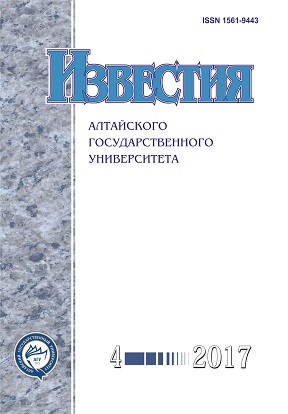Estimation of the Hydrometeors’ Anisotropic Properties Based on the Use of Circular Depolarization Ratio
Abstract
In the paper, a question about an estimation possibility of the hydrometeors’ anisotropic properties by using of circle depolarization ratio is considered and discussed. It is known that the factors limiting the efficiency of the circular depolarization ratio method include the pronounced dependence of the method upon the differential phase shift. The last one is introduced by a propagation medium between orthogonal components of electromagnetic wave. On this basis, a determination of the circular depolarization ratio estimation error is carried out. Such an error appears with an additional phase shift between orthogonal components of an electromagnetic wave. When receiving signals with circular polarization states of the right and left rotation direction, a special attention is given to the evaluation of its phase difference variability. Also, an interpretation of given results stands apart as another important question to discuss. The calculation data are presented and analyzed. In particular, an applicability of the signals’ phase difference estimation procedure is illustrated. It is needed for an implementation of probed meteorological formations identification in case of ambiguous situations. It is found that appearance of the phase shift, introduced by the propagation medium, leads to a significant distinction between the measured circular depolarization ratio value and the polarization anisotropy true value of the probed meteorological formations
DOI 10.14258/izvasu(2017)4-08
Downloads
Metrics
References
Al-Jumily J. K., Charlton R. B., Humphries R. G. Identification of rain and hail with circular polarization radar // Journal ofApplied Meteorology. — 1991. — Vol. 30.
Масалов Е.В., Татаринов В.Н. Поляризационные измерения в задачах радиолокационной метеорологии // Зарубежная радиоэлектроника. — 1987. — №4.
Ryzhkov A., Zhang P., Cao Q., Matrosov S., Melnikov V., Knight M. Measurements of circular depolarization ratio with the radar with simultaneous transmission/reception // ERAD 2014 — The Eighth European Conference on Radar in Meteorology and Hydrology. — 2014. [Electronic resource]. URL: http://www. pa.op.dlr.de/erad2014/programme/ExtendedAbstracts/232_ Ryzhkov.pdf (дата обращения: 18.01.2017).
Nicolet M., Schnaiter M., Stetzer O. Circular depolarization ratios of single water droplets and finite ice circular cylinders: a modeling study // Atmospheric Chemistry and Physics. — 2012. — Vol. 12.
Galletti M., Huang D., Kollias P. Zenith/Nadir Pointing mm-Wave Radars: Linear or Circular Polarization? // IEEE Transactions on Geoscience and Remote Sensing. — 2014. — Vol. 52, № 1.
Jameson A.R., Dave J.H. An interpretation of circular polarization measurments affected by propagation differential phase shift // Journal of Atmospheric and Oceanic Technology. — 1988. — Vol. 5.
Torlaschi E., Holt A.R. A comparison of different polarization schemes for the radar sensing of precipitation // Radio Science. — 1998. — Vol. 33, №5.
Galletti M., Huang D., Kollias P., Giangrande S.E. Towards a CDR-based Rain Rate Estimation Algorithm for Zenith-pointing Cloud Radars at Ka band // ERAD 2012 — The Seventh European Conference on Radar in Meteorology and Hydrology. — 2012. [Electronic resource]. URL: http:// www.meteo.fr/cic/meetings/2012/ERAD/extended_abs/ CR_100_ext_abs.pdf (дата обращения: 25.01.2017).
Татаринов В.Н., Лигтхарт Л.П., Татаринов С.В. Введение в современную теорию поляризации радиолокационных сигналов. Поляризация плоских электромагнитных волн и её преобразования : учебное пособие. — Томск, 2012. — Т. 1.
Бадулин Н.Н., Бацула А.П., Кульшенева Е.Б., Лукьянов С.П., Масалов Е.В., Татаринов В.Н. Экспериментальные исследования анизотропии рассеяния радиолокационных сигналов облаками и осадками // Известия АН СССР Физика атмосферы и океана. — 1984. — Т. 20, №6.
Kumjian M.R. Principles and applications of dualpolarization weather radar. Part 1: Description of the polarimetric radar variables // Journal of Operational Meteorology. — 2013. — Vol. 1(19).
Масалов Е.В., Ещенко С.Ю. Влияние дифференциальных факторов среды распространения на поляризационные характеристики электромагнитной волны // Известия высших учебных заведений. Физика. — 2012. — Т. 55, №3.
Copyright (c) 2017 Е.В. Масалов, А.С. Рудометова, Н.Н. Кривин

This work is licensed under a Creative Commons Attribution 4.0 International License.
Izvestiya of Altai State University is a golden publisher, as we allow self-archiving, but most importantly we are fully transparent about your rights.
Authors may present and discuss their findings ahead of publication: at biological or scientific conferences, on preprint servers, in public databases, and in blogs, wikis, tweets, and other informal communication channels.
Izvestiya of Altai State University allows authors to deposit manuscripts (currently under review or those for intended submission to Izvestiya of Altai State University) in non-commercial, pre-print servers such as ArXiv.
Authors who publish with this journal agree to the following terms:
- Authors retain copyright and grant the journal right of first publication with the work simultaneously licensed under a Creative Commons Attribution License (CC BY 4.0) that allows others to share the work with an acknowledgement of the work's authorship and initial publication in this journal.
- Authors are able to enter into separate, additional contractual arrangements for the non-exclusive distribution of the journal's published version of the work (e.g., post it to an institutional repository or publish it in a book), with an acknowledgement of its initial publication in this journal.
- Authors are permitted and encouraged to post their work online (e.g., in institutional repositories or on their website) prior to and during the submission process, as it can lead to productive exchanges, as well as earlier and greater citation of published work (See The Effect of Open Access).








